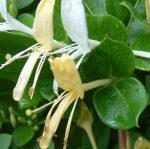J apanese honeysuckle is a deciduous to semi-evergreen perennial vine and a member of the honeysuckle family, Caprifoliaceae, that also includes snowberry, weigelia, and abelia. It is native to eastern Asia but was introduced into the US in the 1800s as an ornamental and now can be found from Maine to Florida and from Michigan and Wisconsin south to Nebraska, Kansas, Oklahoma, and Texas. Plants prefer moist fertile soil in partial sun but tolerate shade and grow in disturbed sites such as roadsides, railroad tracks, field edges, woodland openings, orchards, and gardens. Although the cultivar ‘Hall’s Prolific’/’Halliana’ is a popular groundcover, the species can become very invasive and choke desirable shrubs and trees.
apanese honeysuckle is a deciduous to semi-evergreen perennial vine and a member of the honeysuckle family, Caprifoliaceae, that also includes snowberry, weigelia, and abelia. It is native to eastern Asia but was introduced into the US in the 1800s as an ornamental and now can be found from Maine to Florida and from Michigan and Wisconsin south to Nebraska, Kansas, Oklahoma, and Texas. Plants prefer moist fertile soil in partial sun but tolerate shade and grow in disturbed sites such as roadsides, railroad tracks, field edges, woodland openings, orchards, and gardens. Although the cultivar ‘Hall’s Prolific’/’Halliana’ is a popular groundcover, the species can become very invasive and choke desirable shrubs and trees.
Description: This twining vine grows up to thirty three feet tall and has pairs of oval, sometimes lobed, leaves up to three inches long. The tubular flowers have two reflexed lips with long stamens, and are white fading to yellow. They have a sweet vanilla scent, appear from spring until mid summer, and give way to black berries containing a few seeds. Plants spread by seed and stems that root when they touch the ground.
Control: Pulling, cutting, hoeing, or mowing seedlings or young plants every two weeks until no more plants appear can be effective. Dig out older plants being careful to get the whole root. Alternatively, cover the area with a dense mulch such as cardboard or newspaper for one growing season. In severe cases a late season application of 2.5% glyphosate can be applied to the plant or a 25% glyphosate or triclopyr solution can be applied to freshly cut stems no higher than four inches before the ground freezes.